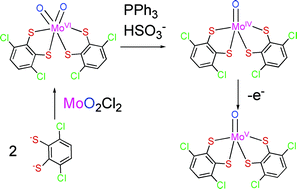A new set of molybdenum-(IV), -(V), and -(VI) compounds containing 3,6-dichloro-1,2-benzenedithiolate (bdtCl2) were isolated and characterised by crystallographic and other spectroscopic techniques as active site models of arsenite oxidase, one of the molybdoenzymes. MoO2 compounds were prepared in high yields by reaction of MoO2Cl2 with bdtCl2, related dithiolene and thiocatecholate in methanol at low temperature. The bdtCl2 ligand particularly stabilised the MoO compounds with oxidation numbers of +4 and +5 as well as the MoO2 compound with an oxidation number of +6. The compounds (Et4N)2[MoVIO2(bdtCl2)2]
(1), (Et4N)2[MoIVO(bdtCl2)2]
(2) and (Et4N)[MoVO(bdtCl2)2]
(3) were successfully isolated, whereas (Et3NH)2[MoO2(thiocatecholate)2]
(6) gradually decomposed in acetonitrile. A distorted octahedral structure similar to that of (1) was suggested for the structure of the active site of the oxidised form of arsenite oxidase on the basis of a comparison of their bond distances and angles. The bond distances and angles around the molybdenum(IV) atom in (2) were similar to those around the molybdenum(IV) centre in the reduced form of arsenite oxidase. The reversible (2)/(3) couple exhibited a more positive redox potential than common MoO dithiolene compounds. (1) underwent an irreversible proton-coupled reduction process to yield (2). An oxygen atom transfer reaction of (1) with triphenylphosphine afforded (2) and triphenylphosphine oxide, and proceeded in second order as v
=
−d/dt
[MoO2]
=
k[MoO2][PPh3]. The structures and properties of the oxo-bridged dinuclear compound (Et4N)2[MoVIO2(bdtCl2)]2(μ-O)
(4), a dimer of bdtCl2
(5) and (6) were also characterised.

You have access to this article
 Please wait while we load your content...
Something went wrong. Try again?
Please wait while we load your content...
Something went wrong. Try again?


 Please wait while we load your content...
Please wait while we load your content...